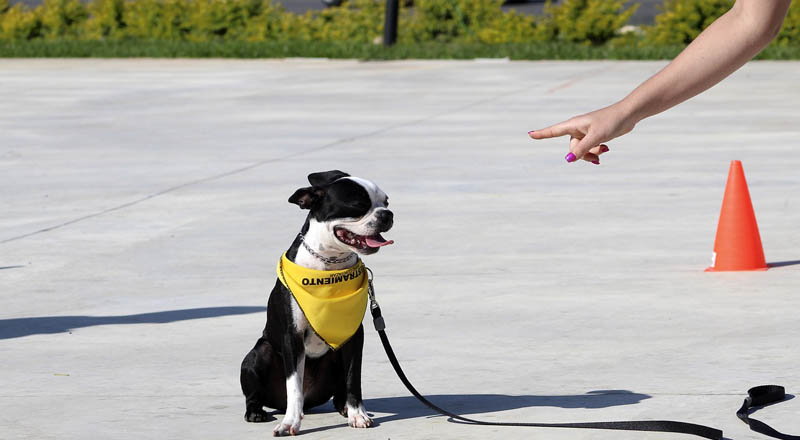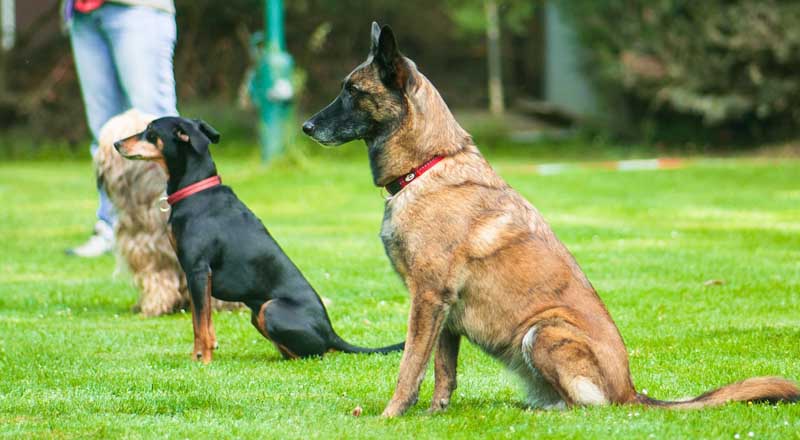Introduction to Canine Compliance
Dog obedience training is all about teaching your dog to respond consistently and reliably to a command. It’s one of the cornerstones of responsible pet ownership, keeping your dog safe, making them a more pleasant companion and ultimately making your relationship with your dog easier for both of you. Obedience training, ultimately, is about communication so your dog is out in the world, able to understand what you want them to do while allowing you to maintain control in a variety of scenarios.
Basic obedience usually entails teaching your dog to sit, stay, come, down and heel. These are life-saving skills that every dog should learn and are often taught using positive reinforcement techniques like treats and praise. But advanced dog obedience takes these basics, expands on them with more complex behaviors, additional impulse control and the ability to perform amid distractions or at a distance. This degree of training isn’t limited to professionally trained working dogs, it’s valuable for any owner hoping for higher reliability and deeper connection to their pet.
There are many advantages to having an advanced obedience training. It also stimulates them mentally and prevents behavior problems and can be a lifesaver in emergencies.
Why Basic Techniques Are Not Enough (And What Are Advanced Techniques)

In order to properly understand advanced dog obedience techniques, it’s important to know what they differ from basic training. So let’s make this easy to understand.
Basic Obedience: The Building Blocks
All dogs start at basic obedience. These command are basic and they are meant to teach good manners and safety. They include:
Sit: The dog sits their hindquarters down.
Stay: The dog will hold a position until commanded to break.
Come: The dog comes to you when called.
Down: The dog is laying on the ground.
Heel (with a leash): The dog walks next to you without pulling.
These skills are typically taught in controlled settings with few distractions and rewards such as treats or praise to motivate the animal. Obedience basics provide foundational skills for all future training by ensuring your dog knows how to learn and follow cues.
High-level Obedience
Advanced obedience is built upon that foundation, with increasingly complex and precise work. It calls on your dog to show more focus, self-control, and flexibility. Advanced techniques are characterized by:
Off-Leash Reliability: You no longer have to rely on a leash to relay commands.
Distance Control: The dog listens from a distance.
Working with Distractions: Not flapping at distractions.
Cues Without a Word: There are some hand signals and body language instead of spoken commands.
Complex Sequences: The dog performs several behaviors in a particular order.
So, for example, where basic training may have taught a dog to sit in your living room, advanced training lets you know they’re going to sit in the middle of a busy park while squirrels whiz past. This development requires dedication, persistence over time, and a good grasp of the fundamentals before advancing. Keeping that difference in mind, let’s take a look at a few particular advanced commands you can teach your dog.
Read Also ; Organic pet food recipes and benefits
Key Advanced Commands
Well advanced dog obedience techniques cover very high-end skills. We’ll outline seven key commands below, explain what they are and give you practical tips on training them. These trick techniques will improve your pooch skills and demonstrate how intelligent they are.
1. Heel (Off-Leash)
What It Is: Your dog walks quietly by your side, keeping pace with you, off leash, even in distracting environments.
What This Means: Off-leash heeling provides both freedom and control great for hikes or public spaces.
How to Train: Begin with on leash heeling, rewarding your dog for hanging close to you with treats or praise. Slowly take away the leash in a fenced space and reinforce that spot with high value rewards. Work in more and more distracting environments, bringing them back to your side with gentle corrections when they start to drift.
2. Stay with Distractions
What Is It: Your dog stays in a sit or down position while faced with temptations such as food, toys or other dogs.
Why It Matters: This develops impulse control and makes it so someone else can rely on you in the real world.
How to Train: Start with brief sits in a quiet room, praising success. While keeping your dog in this posture, slowly introduce mild distractions (a ball is a good place to start) while rewarding the stay with treats. Add distractions slowly barking dogs, doorbell rings and reward your dog for holding position.
3. Recall from a Distance
What It Is: Your dog comes running to you when called, whether you’re standing on opposite ends of the dog park or whether the dog is surrounded by other exciting stimuli.
Why It’s Important: A solid recall can avoid dangerous scenarios like chasing wildlife or running off.
How You Train: Use a long training line (20-30 feet) in a safe space. The dog should be called with a loud “come!” and reward dimly with treats or play when they do. Gradually increase distance and distractions (other people or dogs, for example) until every recall is rewarded in some way.
4. Commands without Sound (Hand Signals)
What It Is: Your dog obeys visual cues a lifted hand for “sit,” for instance without spoken commands.
Why It Matters: Silent commands come in handy when you are in a noisy situation or just want to communicate quietly.
How To Train: Associate a hand signal with a verbal command already known (example: point down for “down”). Repeat a few times and then fade out the verbal cue so that your dog is responding to the signal only. Clarify with variety of environments so condition the behavior.
5. Directional Commands
What It Is: Your dog moves in a given direction left, right, forward, or back by your command.
Why It Matters: It can be useful for agility, service work or maneuvering around objects.
How to Train: With a treat, lure your dog to move in the way you want and say the command (“left,” for example). If they move right, reward them. Once they have connected the word with the action, take away the lure and depend only on the verbal cue.
6. Scent Work
What It Is: Your dog sniffs out certain items or smells, like a hidden toy or treat.
Why It Matters: Scent work engages your dog’s natural instincts, giving them mental exercise and pleasure.
How to Train: Place a treat in plain view and say “find it,” prompting your dog to sniff it out. Progressively conceal objects in more challenging locations, or present new odors (lavender oil, for instance), but reward success each and every time. This can scale up with more sophisticated detection challenges.
7. Emergency Stop
What It Is: Your dog stops on a dime and immediately lies down on command, no matter what else he is doing.
Why It Matters: This is crucial to avoid accidents, such as running onto a busy street or pursuing something unsafe.
How to Do It: When the dog is walking, say “stop” or “down” and lure a down position with a treat. Give them lots of praise and practice on walks or play, gradually stepping up the urgency and distance as they get better.
It takes time and repetition to deliver these commands, but a well-trained dog that responds to commands is worth it.
Read Also ; Dopamine Fasting for Better Focus and Well-being
How to Train for Advanced Obedience
Mastering advanced obedience techniques depends on appropriate training techniques. There are many techniques, but positive reinforcement is both the gentlest and most effective option. Let’s explore some options:
Positive Reinforcement
This approach supports your dog for correct behavior with treats, praise or play. It creates motivation and trust that make learning fun! So for example, with something like an emergency stop, it’s all about getting him the treat and reminding him that, yes, we do that in this situation because it makes sense.
Clicker Training
A clicker is a sound that denotes the exact moment your dog does what you want after which they receive a treat. It’s especially effective for complex commands such as directional cues, in which timing is essential. Once you’ve “charged” the clicker click and treat over and over you can then use it to shape behaviors.
E-Collar Training
Electronic collars provide a gentle shock to reinforce commands, commonly used to work dogs off-leash. When used properly, it can work, but abuse can create stress or panic, which is why this technique is usually reserved for experienced trainers. For most dogs, positive methods are preferable to e-collars.
Whichever method you use, consistency, patience, and short, effective sessions (10-15 minutes) are key! As always, adjust your approach for the personality and needs of your dog.
The Basics and Advanced Training Challenges
There are obstacles to advanced training, too. Here’s how to address some common challenges:
Stubbornness: If your dog resists, increase motivation with better rewards (chicken instead of kibble) and/or make sessions shorter to increase engagement.
Fear or Anxiety: Use gradual exposure to triggers like loud noises and reward calm behavior to build confidence.
Distractions: Work in quiet spaces first, then gradually introduce distractions such as people or dogs and reward for focus with treats.
Inconsistency: Provide clear, consistent cues and make sure everyone in the household follows the same rules.
A professional dog trainer who specializes in advanced obedience can be very helpful if progress stops.
Conclusion
You can use more advanced dog obedience techniques to make your pet a responsive, well-mannered canine companion. Whether off-leash heeling, scent work, or otherwise, these types of skills require responsibility, but pay out in dividends safety, mental stimulation, and a greater relationship. Using positive reinforcement, addressing challenges and building on basic skills, you’ll be able to unlock your dog’s full potential. Every dog learns differently so keep positives and seek professional assistance if you need it. Often available through hunting or herding clubs, they will take time and patience, but advanced obedience will take your training experience to new levels.

